Continuing Development: Web Equipment for the New Technology of Warfare
 The Mills Equipment Company had met with only limited success with its first post-war successor to Web Equipment, Pattern 1908. The Pattern 1919 Naval Web Equipment was in limited service. The Pattern 1919 Rifle Equipment, although technically superior to Patt. '08, was not adopted by the cash strapped British Army, and while it did see service with some Empire and foreign units, it could not be termed a success.
The Mills Equipment Company had met with only limited success with its first post-war successor to Web Equipment, Pattern 1908. The Pattern 1919 Naval Web Equipment was in limited service. The Pattern 1919 Rifle Equipment, although technically superior to Patt. '08, was not adopted by the cash strapped British Army, and while it did see service with some Empire and foreign units, it could not be termed a success.
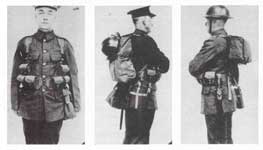 This setback did not deter M.E. Co. from continuing to refine its designs. Chief Designer Albert Lethern and his assistants took another look at the Patt. '19 Rifle Equipment and made a number of changes to various items of the Equipment. The most significant of these was replacing the Pattern 1919 rucksack with a two piece version, in order to increase its flexibility in use. By 1925, the various upgrades and modifications had been incorporated and the revised equipment was ready to be released as a new pattern. The Mills factory photos at right show an early development stage of the new Web Equipment, Pattern 1925. It differs in several interesting minor details from Patt. '25 as it was finally issued and is worth examination. The photo at the beginning of this section shows an early Army demonstration of W.E. Patt. '25.
This setback did not deter M.E. Co. from continuing to refine its designs. Chief Designer Albert Lethern and his assistants took another look at the Patt. '19 Rifle Equipment and made a number of changes to various items of the Equipment. The most significant of these was replacing the Pattern 1919 rucksack with a two piece version, in order to increase its flexibility in use. By 1925, the various upgrades and modifications had been incorporated and the revised equipment was ready to be released as a new pattern. The Mills factory photos at right show an early development stage of the new Web Equipment, Pattern 1925. It differs in several interesting minor details from Patt. '25 as it was finally issued and is worth examination. The photo at the beginning of this section shows an early Army demonstration of W.E. Patt. '25.
There was no global conflict looming over Britain in the mid-twenties. The financial priorities of His Majesty's Government did not include re-equipping the Army, who after all still had several hundred thousand sets of Patt. '08 in store. In an interesting example of bureaucratic double-think, though, the War Office decided that, although its stores of web equipment were sufficient for the Home Country's needs, there was not enough available to re-supply Canada. As early as 1920, the Canadian government was planning the re-equipment of its militias and accordingly requested 100,000 sets of W.E. Patt. '08 from the War Office. The request was denied. The Canadians downsized their request and reapplied for 50,000 sets. They were again turned down, this time with the explanation that the War Office had disposed of its remaining surplus equipment and had none available. The Chanak Crisis of 1922, with its reverberations regarding Canada's relationship to Britain in times of war, caused the Canadian Government to again re-think its military needs. One result of the ensuing planning document was Canada's purchase, in 1927, of a limited number of sets of the Mills Company's latest Web Equipment.
Although the new equipment was identical in every respect to M.E. Co.'s Web Equipment, Pattern 1925, the Canadians adopted it as Web Equipment, Pattern 1919, by Canadian Militia Order No. 500, dated 28th September 1928. According to Brig. Jack Summers in his Tangled Web: Canadian Infantry Accoutrements 1855-1985, the new equipment was called "Pattern 1919" because the use of the back- adjustment strap in the equipment was considered its defining characteristic. In the U.K., this feature had been introduced with the original Web Equipment, Naval, Pattern 1919, a quite different pattern (q.v.). The older term was chosen, we suppose because it made some sort of sense. However, the back- adjustment technique was actually introduced into Canadian (and Empire) service fifteen years earlier with the Canadian Pattern 1913 Web Equipment. Whatever the reason, Canada's decision to use the older designation for this equipment has resulted in considerable confusion among collectors today.
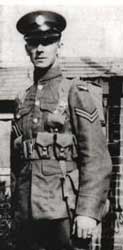 A year before the Canadians adopted their "Pattern 1919", the Royal Air Force had also accepted it into service. A.M.W.O. (Air Ministry Weekly Order) 591/27 - Web Equipment - New Pattern" authorised its adoption in 1927, with A.M.W.O. 793/27 designating it as Web Equipment, R.A.F., Pattern, 1925 and listing its component parts.
A year before the Canadians adopted their "Pattern 1919", the Royal Air Force had also accepted it into service. A.M.W.O. (Air Ministry Weekly Order) 591/27 - Web Equipment - New Pattern" authorised its adoption in 1927, with A.M.W.O. 793/27 designating it as Web Equipment, R.A.F., Pattern, 1925 and listing its component parts.
This equipment differed in one important feature from the Canadian version. Whereas Canadian Patt. '19 was in traditional Army khaki, the new RAF web equipment was dyed blue-grey. The photo at left was graciously provided from his own archives by Andrew Cormack F.S.A., Keeper of Medals, Uniforms and Visual Arts at the Royal Air Force Museum. It shows a RAF corporal wearing blue-grey Patt. '25. Both the RCAF and the RAAF also adopted blue-grey W.E. Patt. '25. In Canada, this led to the interesting situation where the same equipment, differing only in colour, had two different nomenclatures. This disparity continued until around 1930 when, again according to Summers, the name for the khaki version was changed to Web Equipment, 1925 Pattern. This is speculative, as no Canadian Militia documentation has yet been seen after the 1928 Order. The RCAF are presumed to have acted on U.K. A.M.W.O's. Summers speculatively ties the decision to use Rucksacks as the defining factor for nomenclature with Mills’ introduction of their 1928 Two-Part Reversible Rucksack. However, Canada did not adopt this Rucksack design.
Canada bears another distinction relating to W.E. Patt. '25. Until 1940, almost all web equipment in British and Empire service was manufactured in Great Britain, primarily by the Mills Equipment Company and M. Wright & Sons, Ltd. (there were a small number of other British companies that produced a limited selection of the simpler webbing items). Whilst there is solid evidence documenting limited Canadian production as early as 1924, two Canadian firms began producing web equipment in earnest in 1940 (pre-production pieces have been noted with 1939 dates). These were Zephyr Loom & Textile (ZL&T) and the splendidly named Montreal Suspender and Umbrella, Ltd. (MS&U). Neither firm had the special looms needed to duplicate M.E. Co. and M.W.& S. products. Without these looms, Cartridge Carriers, Braces, Pistol Magazine Carriers, Pistol Ammunition Pouches and Holsters, all of which entailed either integral, or reduction weaving, had to be constructed differently. Thus Patt. '25 Cartridge carriers made in Canada can be readily distinguished by their “folded and sewn” pockets.
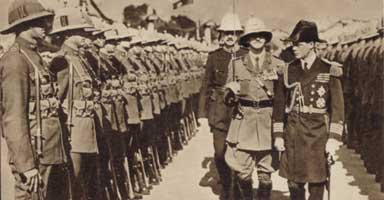 A recent discovery by the accoutrementalist, Rog Dennis, has uncovered evidence of what must have been the very first country to adopt Web Equipment, Pattern 1925, in khaki. This photo, taken from These Tremendous Years 1919-1938 (Daily Express Publication, 1938), shows the then Prince of Wales reviewing troops at Cape Town, in the Union of South Africa, in 1925. This was two years before Patt. '25 was accepted by the RAF (in blue-grey) and three years before Canada adopted it as Patt. '19. Although the exact unit to which these soldiers belonged has not yet been determined, they are clearly South African, and the reduced width Braces and distinctive Cartridge carriers make the identification of the Web Equipment, Pattern 1925 a certainty.
A recent discovery by the accoutrementalist, Rog Dennis, has uncovered evidence of what must have been the very first country to adopt Web Equipment, Pattern 1925, in khaki. This photo, taken from These Tremendous Years 1919-1938 (Daily Express Publication, 1938), shows the then Prince of Wales reviewing troops at Cape Town, in the Union of South Africa, in 1925. This was two years before Patt. '25 was accepted by the RAF (in blue-grey) and three years before Canada adopted it as Patt. '19. Although the exact unit to which these soldiers belonged has not yet been determined, they are clearly South African, and the reduced width Braces and distinctive Cartridge carriers make the identification of the Web Equipment, Pattern 1925 a certainty.
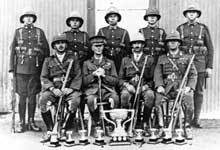 Another early photo of Patt. '25 in use in South Africa has now come to light, provided by sharp-eyed KW Contributor Peter J. Smith. The photograph was taken from a 1926 issue of Nonqai, which was the monthly journal of the South African uniformed forces. It is captioned "Wenner Nonqai Bekker 1926. OC Details Roberts Heights 1926". "Bekker" translates as "cup", as in trophy, and "OC Details" translates as "OC Troops". Roberts Heights was the headquarters of the UDF.
Another early photo of Patt. '25 in use in South Africa has now come to light, provided by sharp-eyed KW Contributor Peter J. Smith. The photograph was taken from a 1926 issue of Nonqai, which was the monthly journal of the South African uniformed forces. It is captioned "Wenner Nonqai Bekker 1926. OC Details Roberts Heights 1926". "Bekker" translates as "cup", as in trophy, and "OC Details" translates as "OC Troops". Roberts Heights was the headquarters of the UDF.
"Pattern 1927" Web Equipment
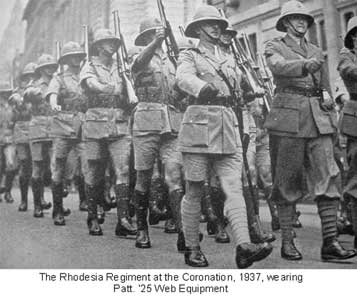 In 2005, a limited number of unusual sets of web equipment appeared on the collectors' market in both the USA and Great Britain. These sets consisted of Patt. '25 Cartridge carriers, Back adjustment strap, Bayonet frog, Braces, Haversack, and Upper rucksack; together with a Patt. '19 Rifle Equipment Entrenching tool carrier and Water bottle carrier, all in khaki. Lower rucksacks and the Rucksack adjusting straps were not included. While in general the pieces were in excellent condition, there was some wear and a few pieces bore traces of pea-green blanco; they had been used. Almost all of the pieces were maker maked "M.E. Co." and dated 1927. After examining of one of these sets, it seems clear to us that this mixture of Patt. '19 and Patt. '25 was both intentional and original to the equipment. The US dealer chose, as a sales convenience, to refer to these as "Pattern 1927" equipment (he was, by the way, perfectly aware of the technical distinctions of the equipment and noted them in his descriptions). That name has stuck among collectors. Since 2005. a trickle of these sets have continued to show up on the collectors market. These are coming from Afghanistan. Afghanistan is one od the countries Lethern lists in the Golden Jubilee booklet as a M.E. Co. customer. No know documentation survives to define exactly what was sold to that country, but it seems most likely that Afghanistan was the original user of "Patt. '27" equipment. As has been previously discussed, there were a number of Empire and foreign military and para-military organisations that purchased both Pattern 1919 and Pattern 1925 Web Equipment in various incarnations. The picture at left, showing the Rhodesian Regiment in Patt. '25 at the coronation of King George VI in 1937, is one such example.
In 2005, a limited number of unusual sets of web equipment appeared on the collectors' market in both the USA and Great Britain. These sets consisted of Patt. '25 Cartridge carriers, Back adjustment strap, Bayonet frog, Braces, Haversack, and Upper rucksack; together with a Patt. '19 Rifle Equipment Entrenching tool carrier and Water bottle carrier, all in khaki. Lower rucksacks and the Rucksack adjusting straps were not included. While in general the pieces were in excellent condition, there was some wear and a few pieces bore traces of pea-green blanco; they had been used. Almost all of the pieces were maker maked "M.E. Co." and dated 1927. After examining of one of these sets, it seems clear to us that this mixture of Patt. '19 and Patt. '25 was both intentional and original to the equipment. The US dealer chose, as a sales convenience, to refer to these as "Pattern 1927" equipment (he was, by the way, perfectly aware of the technical distinctions of the equipment and noted them in his descriptions). That name has stuck among collectors. Since 2005. a trickle of these sets have continued to show up on the collectors market. These are coming from Afghanistan. Afghanistan is one od the countries Lethern lists in the Golden Jubilee booklet as a M.E. Co. customer. No know documentation survives to define exactly what was sold to that country, but it seems most likely that Afghanistan was the original user of "Patt. '27" equipment. As has been previously discussed, there were a number of Empire and foreign military and para-military organisations that purchased both Pattern 1919 and Pattern 1925 Web Equipment in various incarnations. The picture at left, showing the Rhodesian Regiment in Patt. '25 at the coronation of King George VI in 1937, is one such example.
"Pattern 1928" Web Equipment
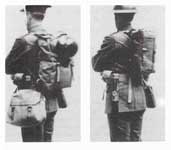 Unlike the collector's designation "Pattern 1927", Pattern 1928 Web Equipment is an original Mills designation for a specific variation of its back adjustment equipment. It differs from W.E. Patt. '25 in the form of the Rucksack. The Patt. '28 Rucksack, like the Patt. '25 one, is designed in two pieces, but here the Upper rucksack rotates 90° when worn alone, to make it more comfortable. It should be noted that "Pattern 1928" was a Mills factory designation only; this was not a pattern adopted by the War Office.
Unlike the collector's designation "Pattern 1927", Pattern 1928 Web Equipment is an original Mills designation for a specific variation of its back adjustment equipment. It differs from W.E. Patt. '25 in the form of the Rucksack. The Patt. '28 Rucksack, like the Patt. '25 one, is designed in two pieces, but here the Upper rucksack rotates 90° when worn alone, to make it more comfortable. It should be noted that "Pattern 1928" was a Mills factory designation only; this was not a pattern adopted by the War Office.